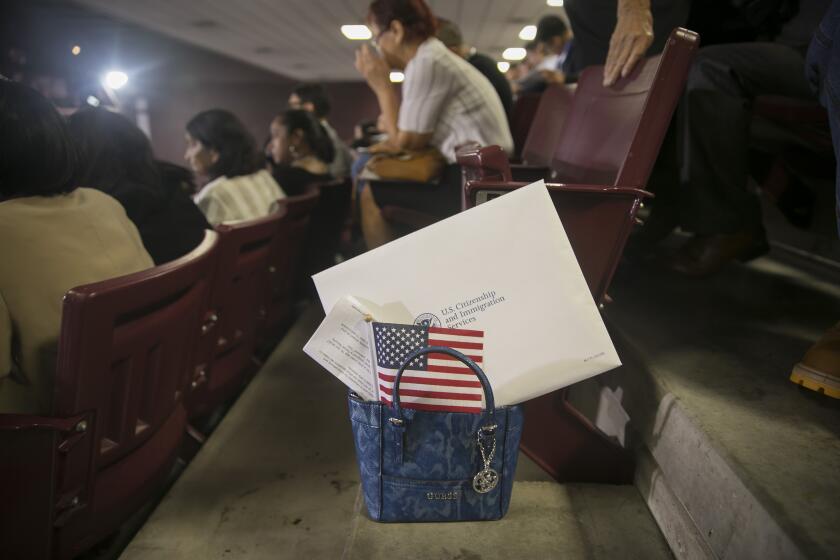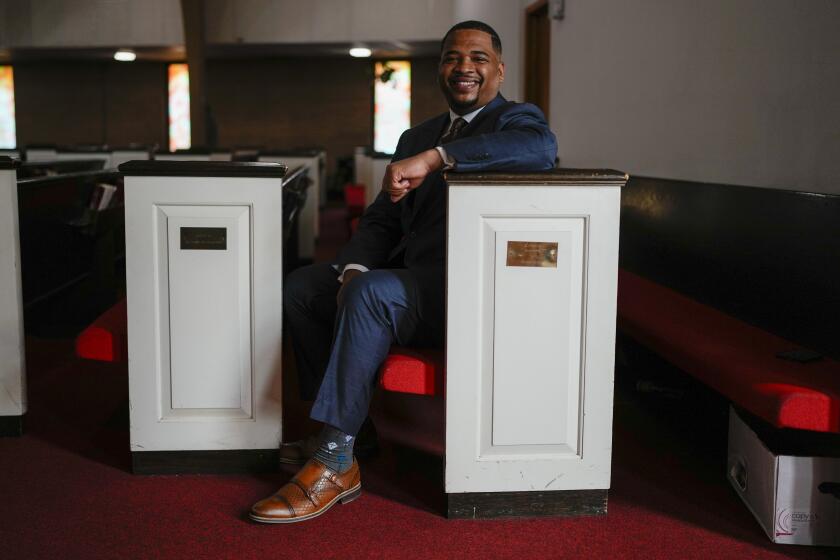ICE deported him to Afghanistan, then flew him back to L.A.

Last summer, nearly a year after the Taliban took over his country, Mr. A, an Afghan man in his 20s, crossed the southern border in California and told authorities he was seeking asylum.
On Jan. 27, in a decision they would later reverse, U.S. authorities deported Mr. A back to the country he had fled.
He hid in fear in Afghanistan, convinced the Taliban would find him, as his attorneys attempted to convince the government that his deportation was a mistake and he needed to be returned.
On Feb. 21, the U.S. government paid to fly Mr. A back to Los Angeles. The extremely rare move, which amounts to an admission that Mr. A’s deportation was at least premature, did not end his ordeal: He has been in ICE custody ever since. The U.S. government has continued to pursue his deportation, though the 9th Circuit Court of Appeals recently put a temporary stay on his removal from the country.
The deportation — and hurried return — of Mr. A indicates that ICE is sending people back to other countries, even dangerous ones such as Afghanistan, without complete information about their cases, his attorneys say. The case of Mr. A, whom The Times is identifying by the first initial of his first name because he fears that the Taliban will kill his family if they realize he sought asylum in the U.S., is an especially fraught example. He came to the U.S. after fleeing a country that the U.S. occupied for two decades and left dangerous and in disarray.
“It was one of the most egregious things I’ve seen as an immigration lawyer,” said Tania Linares Garcia, an attorney with the National Immigrant Justice Center who represents him. “Especially after the U.S. government evacuated so many people. Why they would prioritize the … removal for someone to Afghanistan is baffling to us.”
As of last year, ICE did not keep records on how many immigrants it deported by mistake while their cases were still being adjudicated, according to an internal Department of Homeland Security investigation obtained by The Times. ICE, therefore, had no way of knowing whether erroneous removals were rare, the report, which was conducted by the agency’s civil rights watchdog, concluded.
Sunil Varghese, policy director at the International Refugee Assistance Project (IRAP), said that while he could not comment on individual cases, U.S. deportations to Afghanistan deserve special scrutiny and extreme care.
“Afghanistan is a dangerous place for broad swaths of people, including those affiliated with the U.S. government,” Varghese said. “The very imprimatur of arrival in Afghanistan via a U.S. facilitated flight can be dangerous.”
Mr. A initially left Afghanistan in 2022. He reached the U.S. border in late June after traveling from South America, and crossed without authorization into California, where he was taken into custody and held by ICE for seven months. ICE detained him during the entirety of his initial asylum hearings, in which he was not represented by an attorney.
In late November, an immigration judge ordered him deported. The NIJC helped him submit an appeal shortly before the deadline to file, the group told The Times.
In immigration proceedings, deportations are generally paused while appeals are processed and heard.
But on Jan. 27, Mr. A was deported from the detention center in which he was being held in Southern California. ICE wasn’t aware of his appeal until after his deportation, an ICE spokesperson said.
“Why would I be deported to Afghanistan? That is not legal,” he told The Times later through an interpreter.
ICE deportations to Afghanistan are extremely rare. In the fiscal year of 2020, before the U.S. armed forces left the country, the agency had deported just 25 Afghans. That number dropped to 14 in the following year and 12 in the 2022 fiscal year, which ended in September. The agency has previously touted the criminal record of Afghans it has deported.
“As a federal law enforcement agency, ICE would not intentionally remove a noncitizen from the United States in violation of law or policy,” an ICE spokesperson said in a statement to The Times. “In the rare cases when ICE removes someone from the country in error, ICE works to remedy the situation. In this case, ICE facilitated the noncitizen’s return once the agency learned of the appeal.”
When Mr. A was in an airport waiting to go back to Afghanistan, he began destroying the documents he had for his asylum case, he said.
“I just couldn’t imagine if they see me with these documents, what they would do with me — they would have killed me. For my own safety, I destroyed those,” he said.
The Taliban questioned Mr. A upon his arrival, he said. They asked where he had gone. He did not mention his journey to the U.S.
For nearly three weeks, he said, he hid in Afghanistan while his attorneys figured out how to get him back to the U.S. The lawyers contacted ICE officials and lawmakers and pressured the government to guarantee his return to the U.S.
“I was basically waiting for the Taliban to come after me. I couldn’t sleep,” he said of his time in Afghanistan.
The agency has been forced to bring back people it has deported in the past. In 2019, ICE mistakenly removed an Iraqi man, Muneer Subaihani, after a federal court judge ordered the agency not to do so. The same federal court judge ordered ICE to buy Subaihani a plane ticket and allow his entry into the U.S. Last year, an El Salvadoran man sued ICE after he alleged he was unlawfully deported in 2019 and, upon his return to his home country, put in prison for nearly 300 days.
In mid-February, the U.S. government agreed to allow Mr. A to come back to the U.S. ICE worked with the State Department and his attorneys to bring him back, an agency spokesperson said.
As he sat on a plane headed for home, he was convinced the Taliban would come on the flight and take him away.
“OK, they are coming,” he thought to himself.
But, to his relief, Mr. A was able to escape Afghanistan and come back to the country where he had previously sought safety. He landed at Los Angeles International Airport on Feb. 21.
He expected to have a chance to pursue his asylum appeal as a free man. In fact, the group representing him told the government it had a sponsor waiting for him in Chicago who will house him and pay for his life while he gets settled in the country.
The group implored ICE to offer him a chance to avoid detention and live in Chicago before he returned to the U.S. They explained that not only did he not have a criminal record but also that the Biden administration had set up a process, Operation Allies Welcome, that helped facilitate the evacuation of Afghans for America.
“Such programs are intended to facilitate the entry into the United States so that persons in similar positions to [Mr. A] can present their claims for protection,” they wrote to ICE.
ICE officials did not accept the request. They took him to the Imperial Regional Detention Facility, which is where ICE holds immigrants.
“They put me in jail for no crimes — I have not committed crimes anywhere in the world,” he said.
His case, advocates say, also highlights the problems within the immigration system when immigrants represent themselves in asylum hearings, as Mr. A did initially.
Mr. A did not have an immigration attorney when he was ordered deported in immigration court. The government says that, in those hearings, he waived his right to appeal. His attorneys say he was unaware that he had done so, as evidenced by the fact that they later helped him file an appeal. Migrants who do not have attorneys are generally less likely to win in court.
The NIJC had helped Mr. A file his appeal in December, but the group says the Board of Immigration Appeals misplaced the document after it was delivered. A Justice Department spokesperson said the government could not comment on that claim unless Mr A. formally waives his privacy rights.
Mr. A’s lawyers later resubmitted his appeal after noticing that the governmental website that shows cases’ status had not been updated. By Jan. 24, the NIJC lawyers said, they received a notice that the appeal had been filed and the website showed that his case was pending.
The immigration appeals board, however, said in a March decision that Mr. A had waived his right to appeal after he was ordered deported in November. In a footnote, the appeals board said Mr. A did not file his appeal in a timely manner but said it would not further consider the issue.
“It is bad enough that asylum seekers have to face potentially life-or-death cases, isolated in detention, with no right to appointed counsel and limited procedural protections,” Linares Garcia said. “It is unconscionable to then curtail their ability to seek redress from errors in a system that is known to be overburdened, or to expect them to exercise their right to appeal while living in hiding after being wrongfully removed.”
Mr. A’s attorneys have now gone to the 9th Circuit Court of Appeals, where they have argued that he was unaware he had waived his right to appeal. The appeals court has placed a stay on his deportation while it considers the matter.
The 9th Circuit could rule in Mr. A’s favor and send the case back to the immigration courts or deny his effort, leaving him again vulnerable to deportation. Mr. A could also separately try to reopen his asylum case.
His attorneys have pleaded with the government in the weeks after his return to the U.S. They hope he will have a chance to pursue his case outside of detention.
In a letter to DHS Secretary Alejandro Mayorkas, the lawyers say that Mr. A had told them that he feels helpless and “does not understand why he is being treated in such a callous way.”
More to Read
Get the L.A. Times Politics newsletter
Deeply reported insights into legislation, politics and policy from Sacramento, Washington and beyond. In your inbox three times per week.
You may occasionally receive promotional content from the Los Angeles Times.







